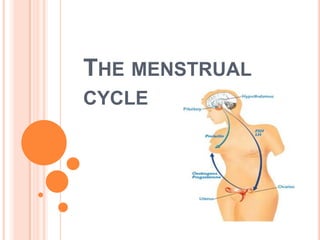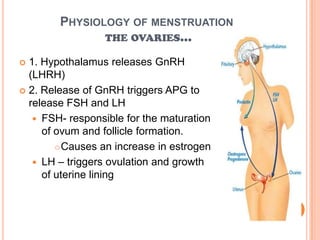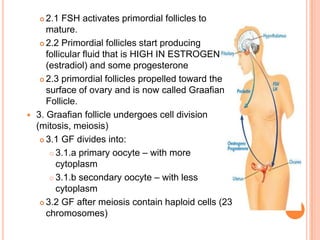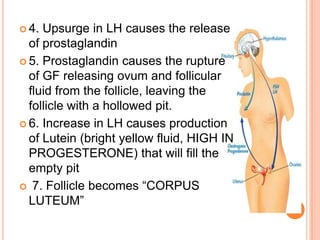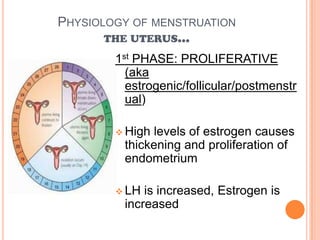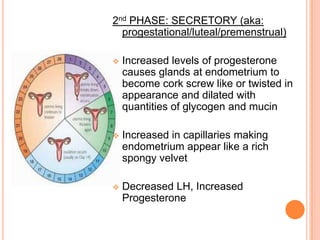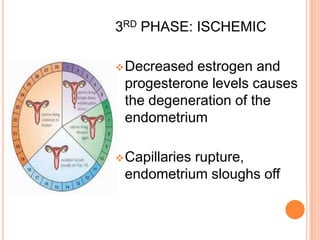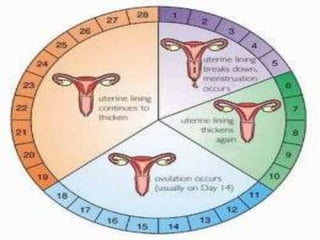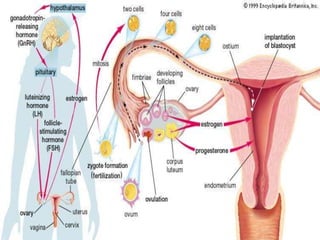The menstrual cycle
- 2. Physiology of menstruationthe ovaries...1. Hypothalamus releases GnRH (LHRH)2. Release of GnRH triggers APG to release FSH and LHFSH- responsible for the maturation of ovum and follicle formation.Causes an increase in estrogenLH â triggers ovulation and growth of uterine lining
- 3. 2.1 FSH activates primordial follicles to mature.2.2 Primordial follicles start producing follicular fluid that is HIGH IN ESTROGEN (estradiol) and some progesterone2.3 primordial follicles propelled toward the surface of ovary and is now called Graafian Follicle.3. Graafian follicle undergoes cell division (mitosis, meiosis)3.1 GF divides into:3.1.a primary oocyte â with more cytoplasm3.1.b secondary oocyte â with less cytoplasm3.2 GF after meiosis contain haploid cells (23 chromosomes)
- 4. 4. Upsurge in LH causes the release of prostaglandin5. Prostaglandin causes the rupture of GF releasing ovum and follicular fluid from the follicle, leaving the follicle with a hollowed pit.6. Increase in LH causes production of Lutein (bright yellow fluid, HIGH IN PROGESTERONE) that will fill the empty pit 7. Follicle becomes âCORPUS LUTEUMâ
- 5. 7.1 if fertilization occurs, ovum implants at the uterus, corpus luteum stays inside the ovaries until 16-20 weeks; trophoblast begin secreting HCG7.2 without fertilization, ovum atrophies after 4-5 days, CL remains for only 8-10 days.7.2.a CL replaced by white fibrous tissue, CL becomes âCORPUS ALBICANSâ
- 6. Physiology of menstruationthe uterus...1st PHASE: PROLIFERATIVE (aka estrogenic/follicular/postmenstrual)High levels of estrogen causes thickening and proliferation of endometrium
- 7. LH is increased, Estrogen is increased2nd PHASE: SECRETORY (aka: progestational/luteal/premenstrual)Increased levels of progesterone causes glands at endometrium to become cork screw like or twisted in appearance and dilated with quantities of glycogen and mucin
- 8. Increased in capillaries making endometrium appear like a rich spongy velvet
- 9. Decreased LH, Increased Progesterone3RD PHASE: ISCHEMICDecreased estrogen and progesterone levels causes the degeneration of the endometrium
- 10. Capillaries rupture, endometrium sloughs off4TH PHASE: MENSES/MENSTRUAL FLOWmenses is composed of:
- 11. Blood from the ruptured capillaries
- 13. Fragments of endometrial tissue
- 14. Microscopic, atrophied, unfertilized ovum
- 15. Total blood loss: 30-80ml
- 16. Iron loss: 11mg
- 17. Physiology of menstruationthe cervix...1st half of the cycleHormones decreased
- 18. Mucus thick and scanty
- 19. Poor sperm survivalOvulation Estrogen is increased
- 20. Cervical mucus thin and copious
- 21. Excellent sperm survival2nd halfDecreased progesterone level
- 22. Mucus is thick
